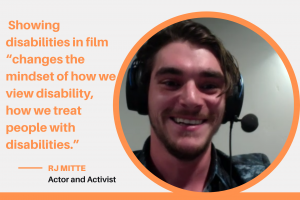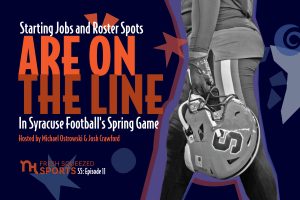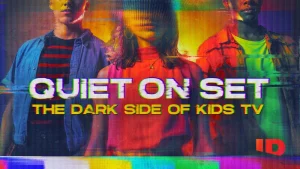Column: A call for accurate disability representation in TV and films
Column: A call for accurate disability representation in TV, films

Introducing The Wheelchair Quarterback: SU magazine senior Joey Pagano’s new column will regularly appear on The NewsHouse this semester and feature insights on issues facing people with disabilities with a focus on empowerment. Inspired by first-hand experiences, The Wheelchair Quarterback will be reported with a solutions- and advocacy-journalism approach.
When RJ Mitte burst onto the Hollywood scene a decade ago, he was surprised. He saw only three people with disabilities working as actors like himself, and the normality of his cerebral palsy became an abnormality.
It was unfamiliar territory for Mitte, who had grown up around family members with diabetes, polio, dementia or who had suffered strokes. He didn’t notice how unique he was.
As a child in Mississippi, he thought “having a disability was a normal thing.”
Once Mitte moved to Los Angeles, began acting and eventually was tapped to play Walter White’s son in Breaking Bad by age 16, he quickly realized he was in an industry where actors, actresses and directors distance themselves from disability, and he had an opportunity to help change that.
“That helped me realize how important it is to have representation on television, to show individuals with disabilities on television, to have stories that feature people with disabilities,” Mitte said during Thursday’s discussion hosted by Syracuse University’s Disability Cultural Center and University Union. “Maybe not (making) the story itself around them, but just (having them) there.
“Because there is nothing disabled about us unless you choose to put it forward.”
SU education associate professor Julia White said movies and TV shows often emphasize what’s “disabled” about people with disabilities and attributes that lead to the disability community being left out of conversations about race, gender and diversity in entertainment.
White said this is highlighted by Sia’s recent film, Music, which has a non-autistic actress playing an autistic role. The movie puts the main character in situations where she is being violently restrained in a way that has killed people with disabilities in the past. The movie is a microcosm of a larger problem in film, where actors with disabilities are facing rejection and losing their roles to nondisabled people, White said. Notable shows that have recently interrupted this trend include Switched at Birth — which featured Mitte — and Speechless, she added.
Some have excused Sia’s decision — and the overall lack of people with disabilities in the film — by bringing up the shortage of autistic actors or basing it off of acting skills, White said. When it happens over and over, it’s not about acting skills, it’s a systemic problem, she added.
The media doesn’t portray people with disabilities like other groups of people, rather like sorrowful creatures or heroes, White said.
“The tropes around disability in media are that disabled people are evil or dangerous villains, or they are angelic children even as adults — or objects of pity or they are superheroes,” White said. “These portrayals have real implications for disabled people in schools, the workplace, and the community.”
According to a 2018 Ruderman White Paper study on authentic representation in TV, 22% of characters with disabilities were portrayed by an actor or actress with the same disability in network television.
Computer science junior Jack Willis said the problem is cyclical. The scarcity of actors with disabilities, though reducing, forces a question about characters with disabilities strictly being played by disabled actors, said Willis, a wheelchair-user. He fears the shortage will continue to lead to few movies involving disabled characters.
Willis hopes to see more actors and actresses with disabilities in roles that don’t center on disability. It would be counterintuitive to have more actors with disabilities and then have them solely there to discuss their disability, he said.
These generalizations come from the societal misunderstanding that people with disabilities are missing something, Willis said. While some people with disabilities, like military veterans, should be celebrated as heroes who overcame adversity, he said, the narrative is often universally used in the media to cover all people with disabilities.
“It becomes the exact thing that these well-intended things attempt to circumvent,” he said. “I think not including disability in film is a way of hiding an undesired irregularity from culture.”
Mitte said he remains optimistic having seen more actors and actresses with disabilities in the past few years, yet Hollywood doesn’t empower the disability community nearly enough. He said he fears diversity has become a formula, where directors feel responsible to intentionally cast people with disabilities.
Mitte doesn’t see a purpose in the formulaic approach. Whether it involves people with disabilities or another group, it’s manipulative in terms of the actual portrayal. He said representation shouldn’t be forced but instead guided forward as it has been recently.
“I see hundreds of thousands of people with disabilities working every day now, and so yes, we do have a long way to go,” Mitte said. “But I’ve seen such an amazing change and positive change for communities when it comes to working with disabilities.






